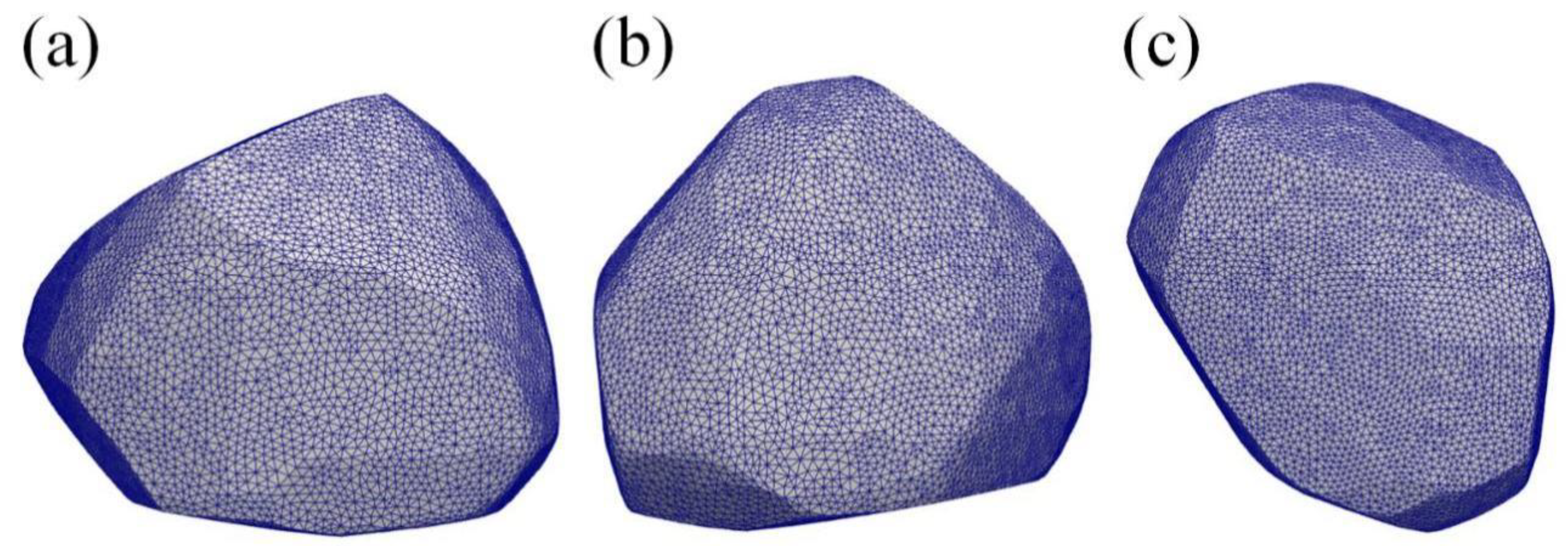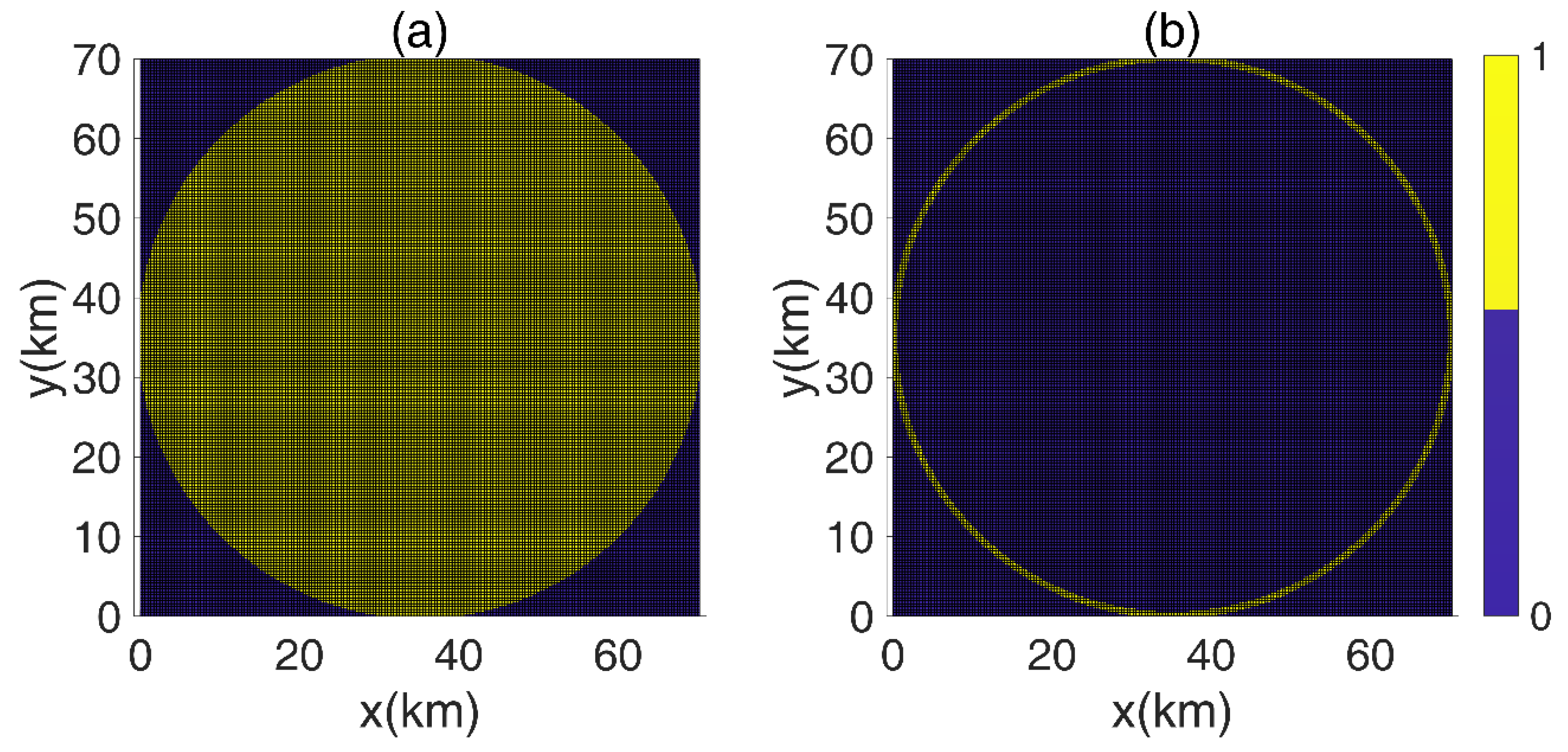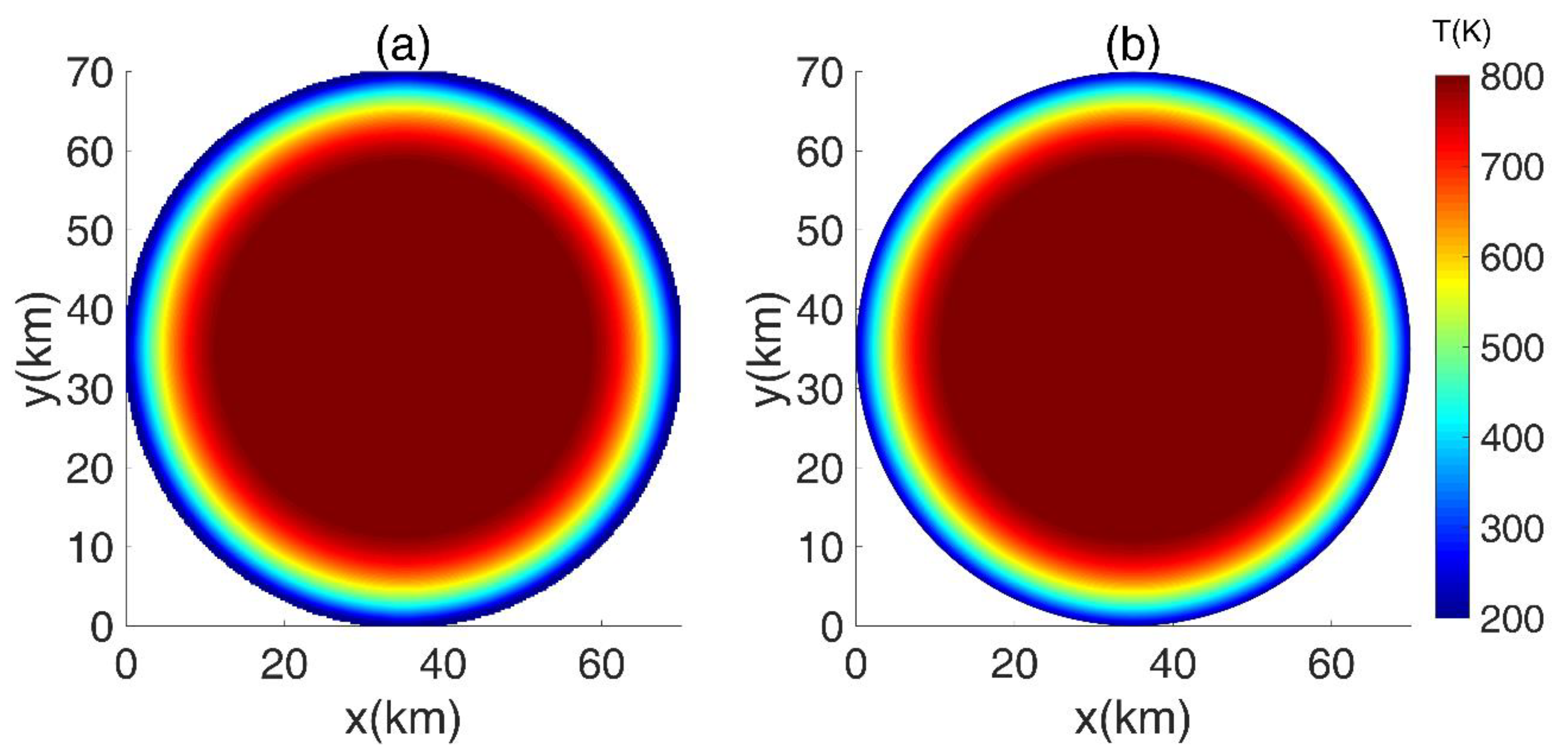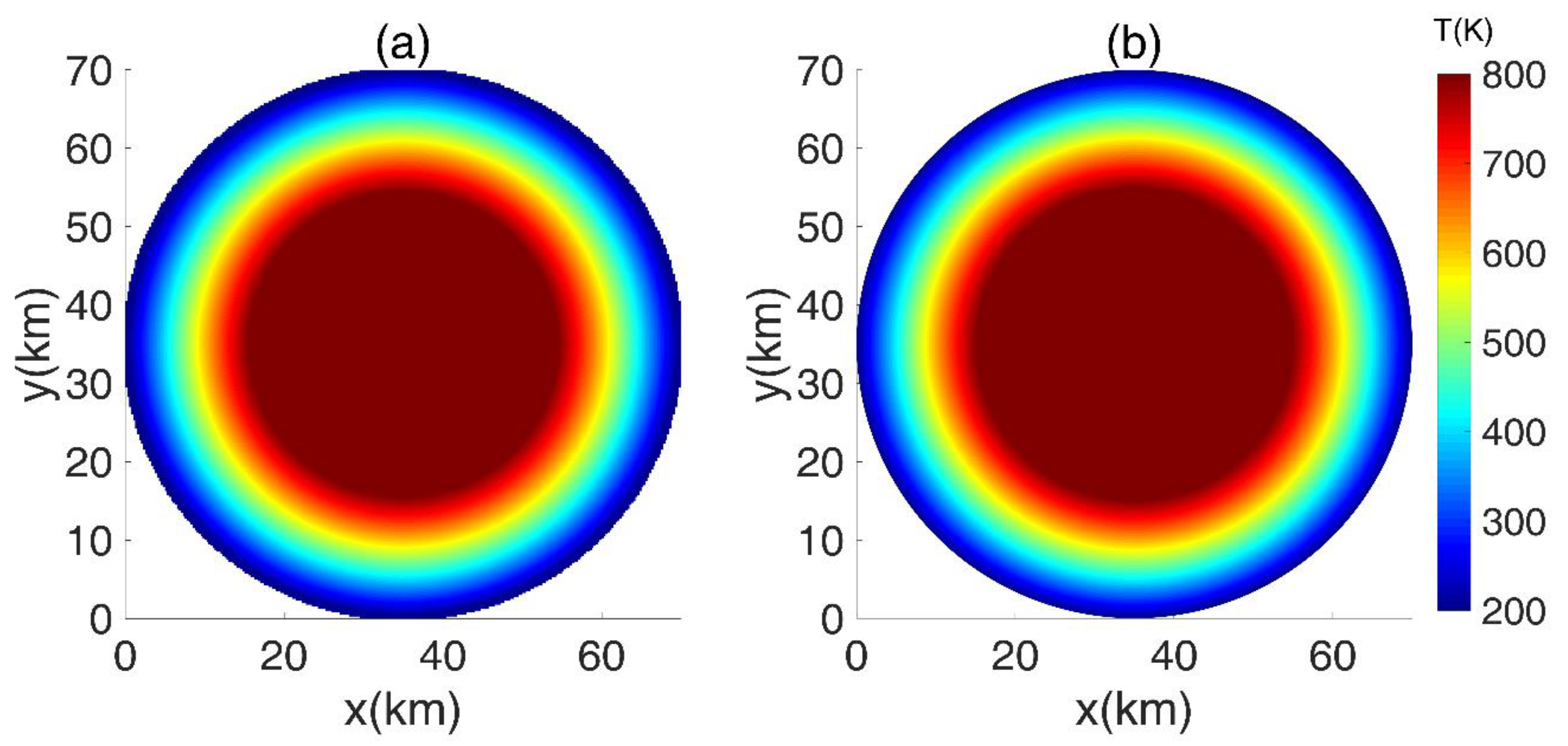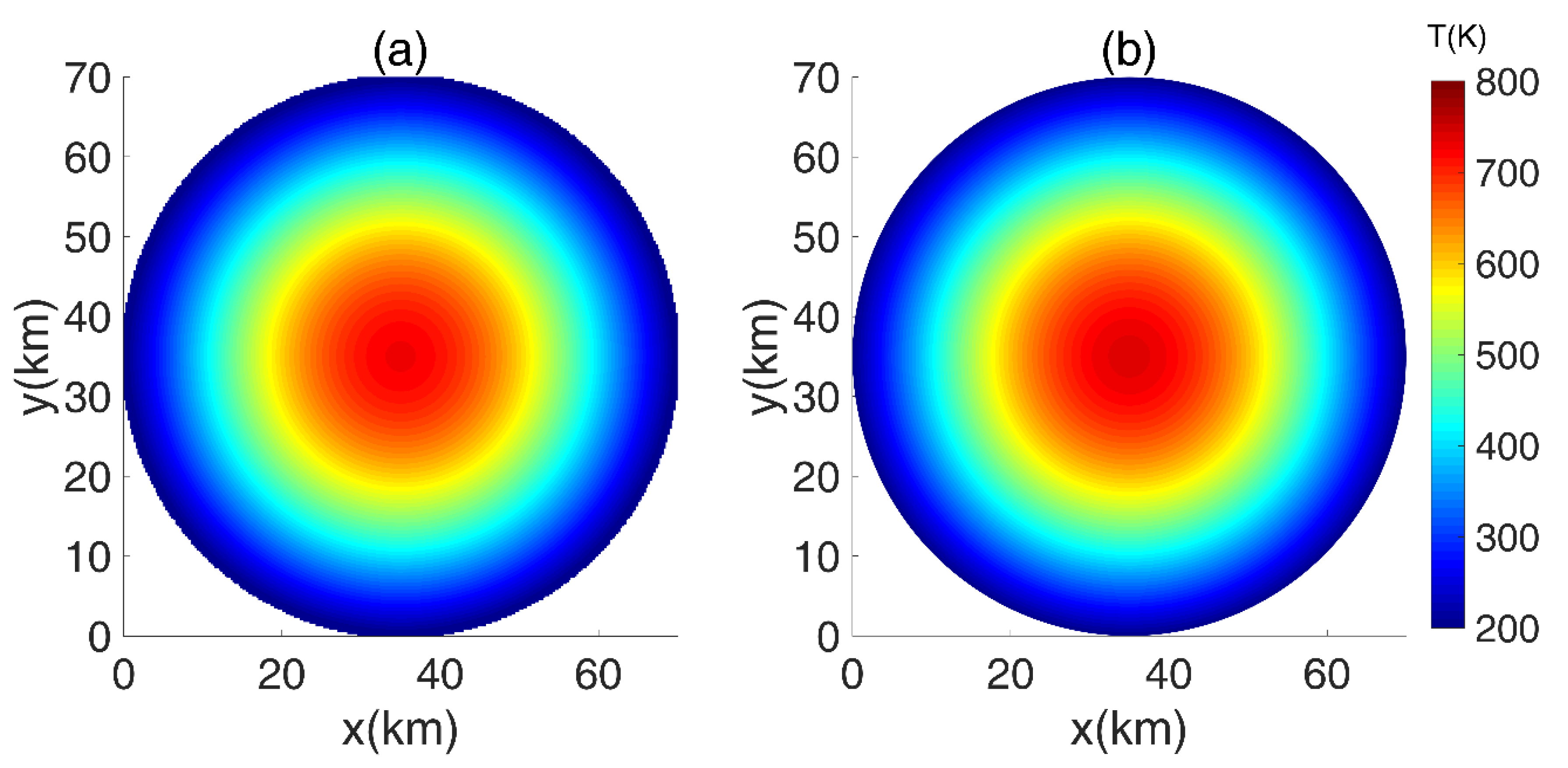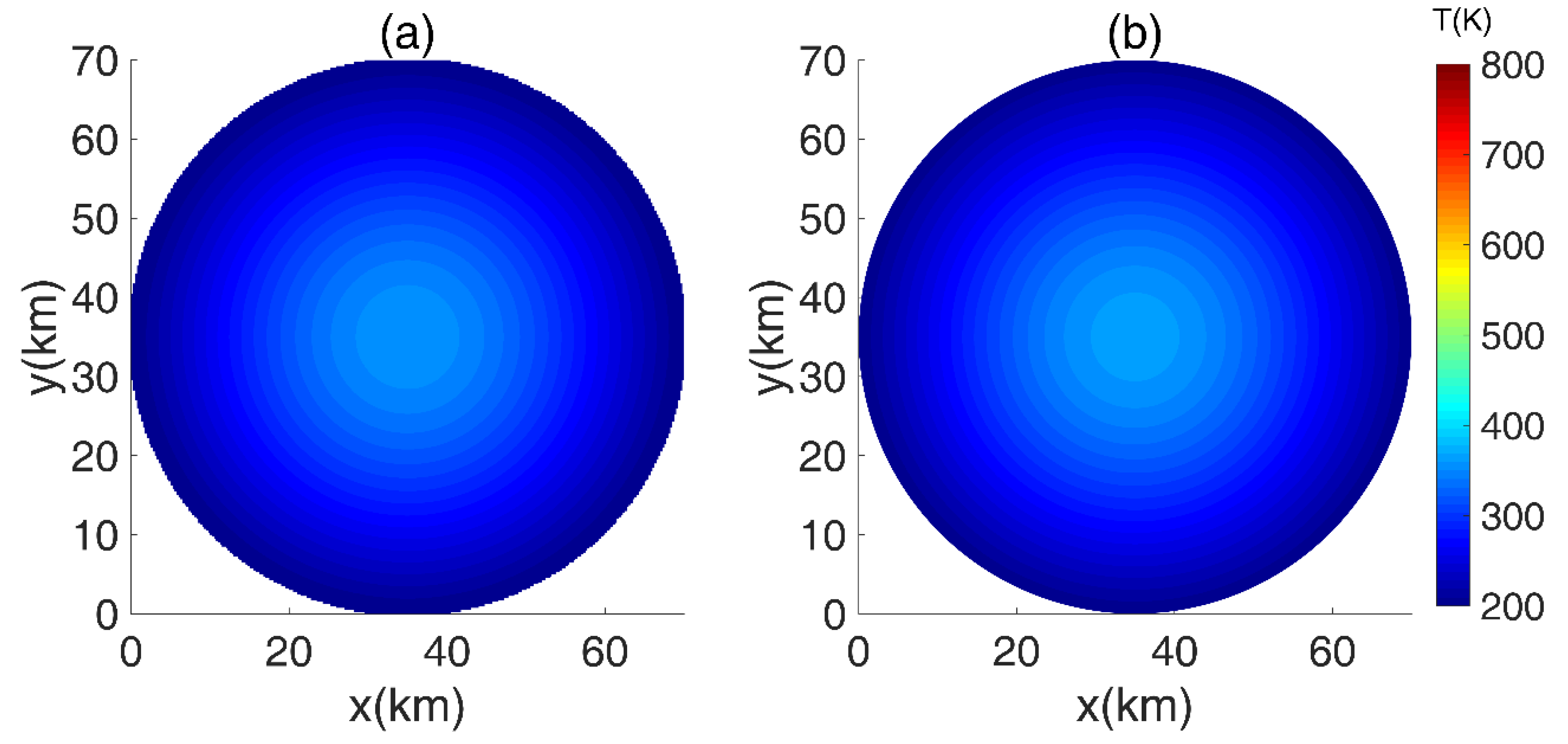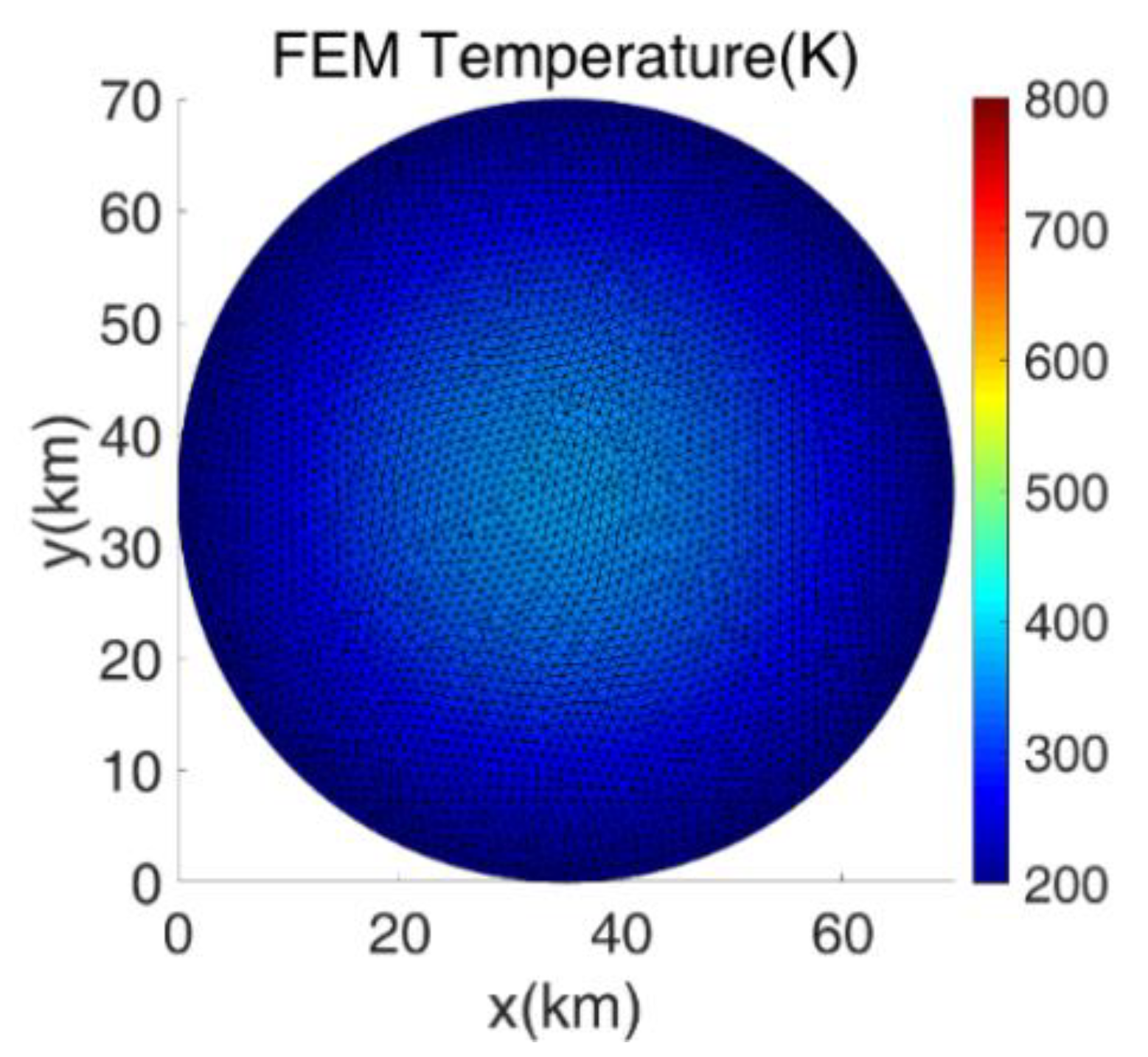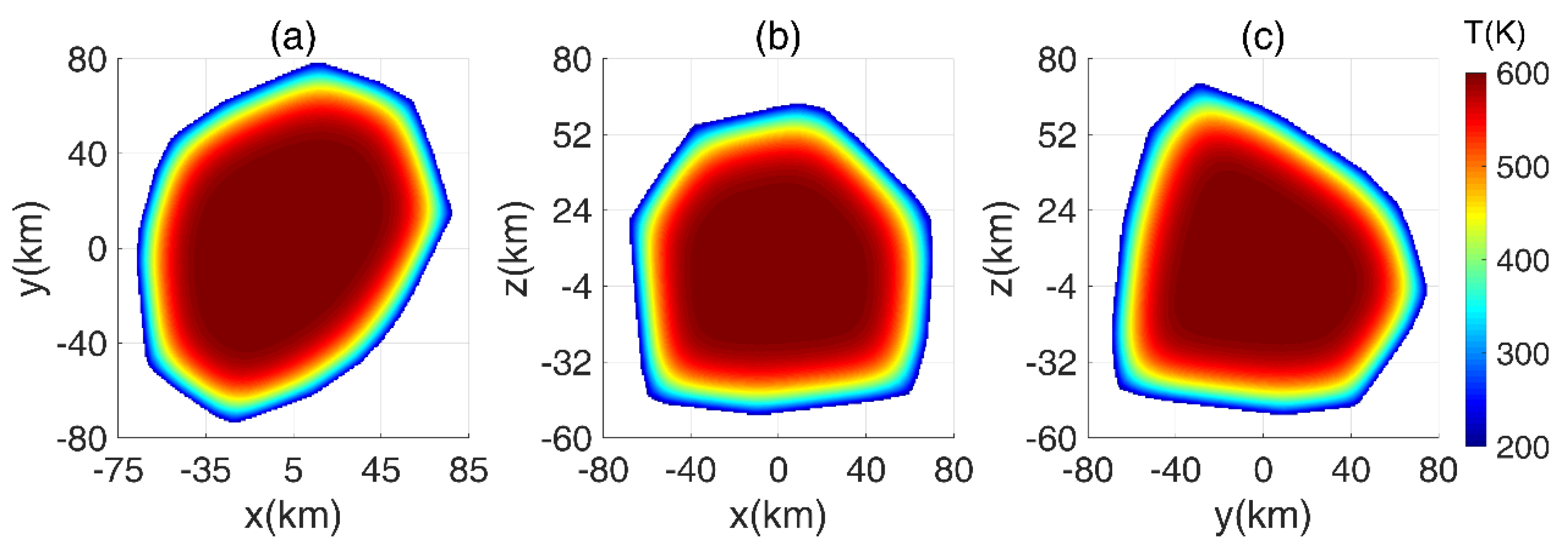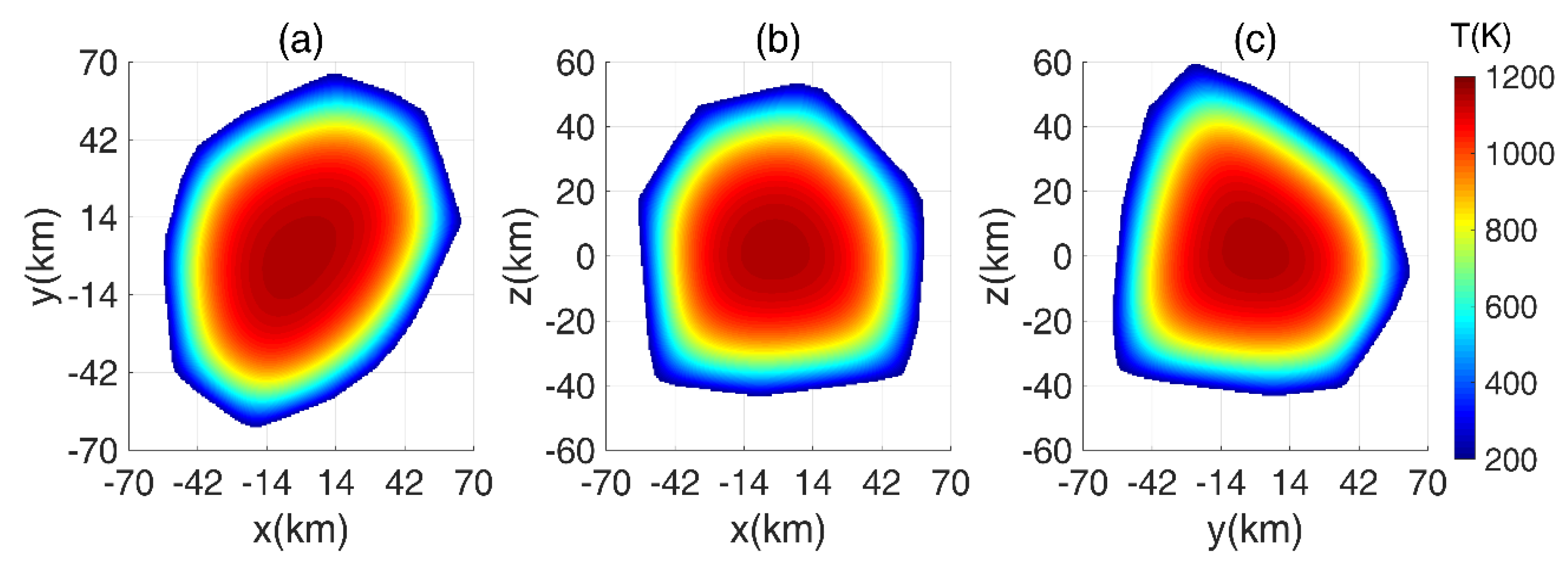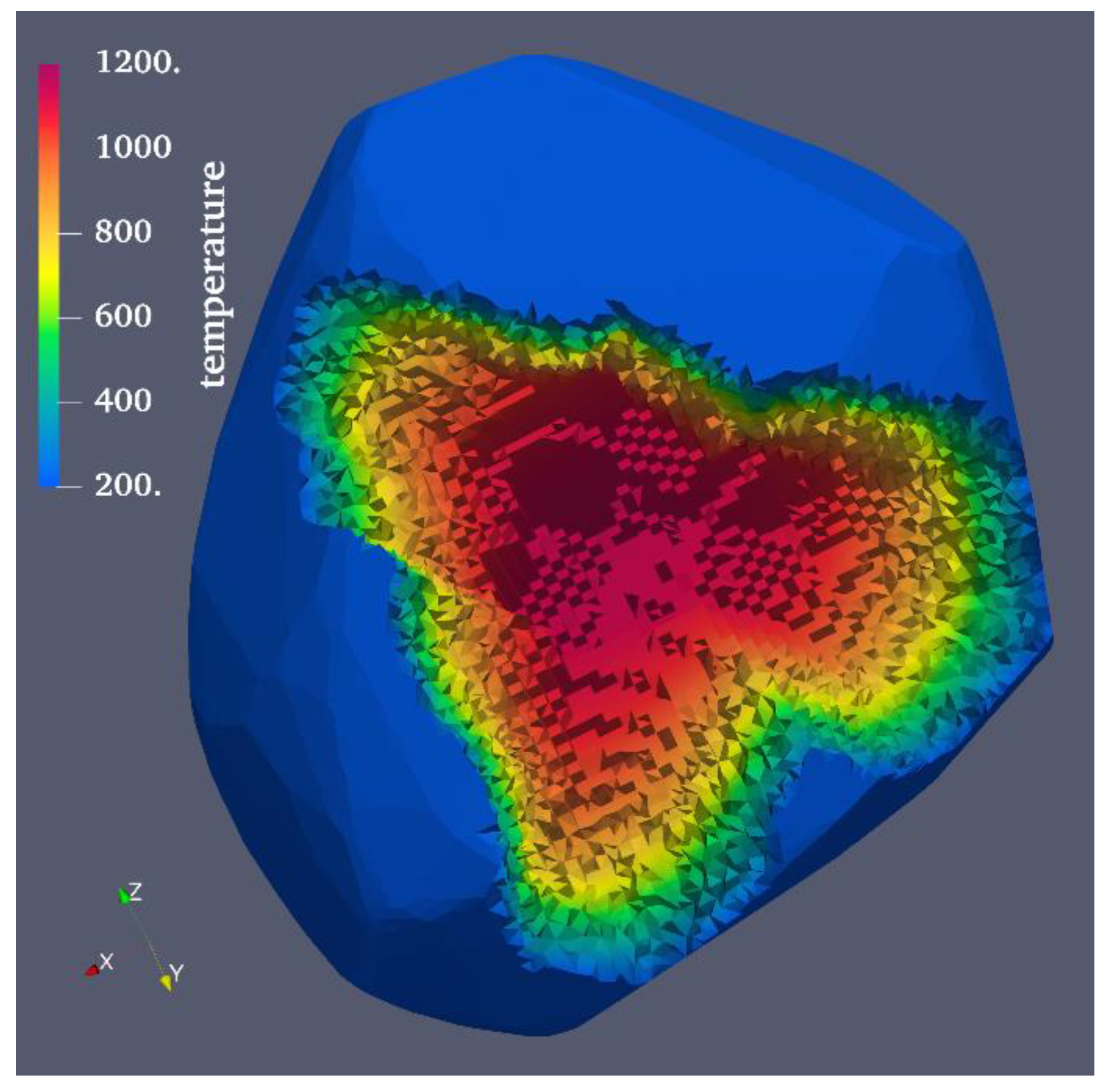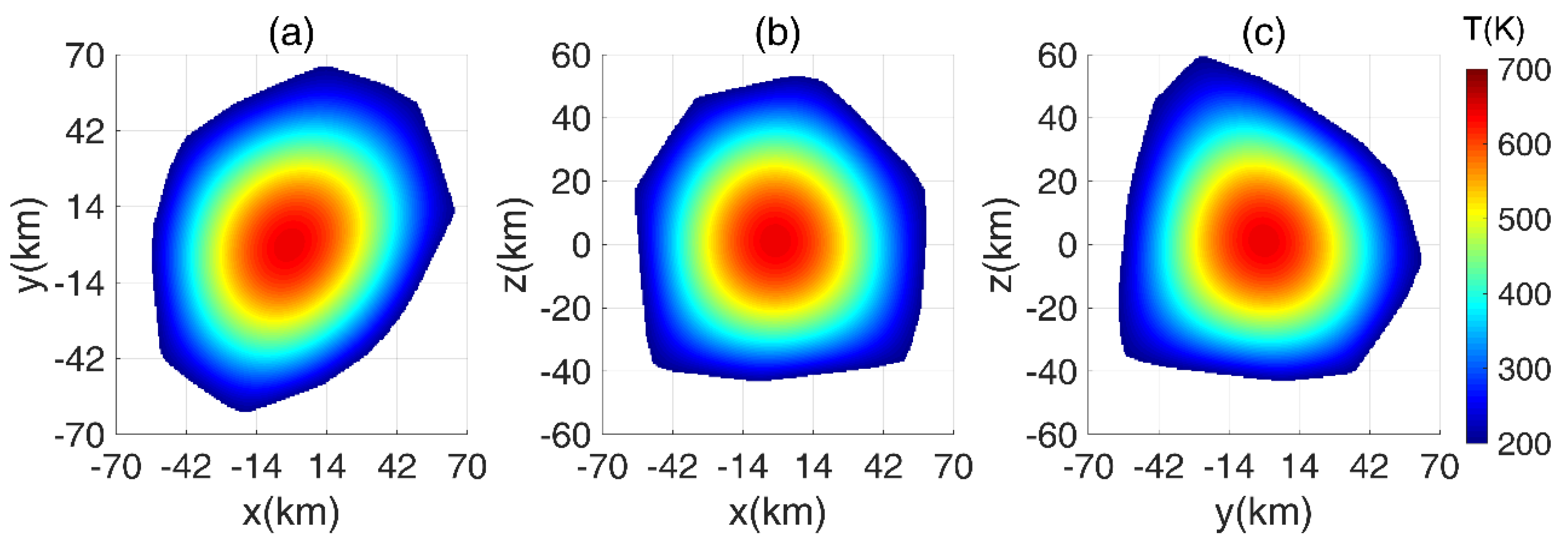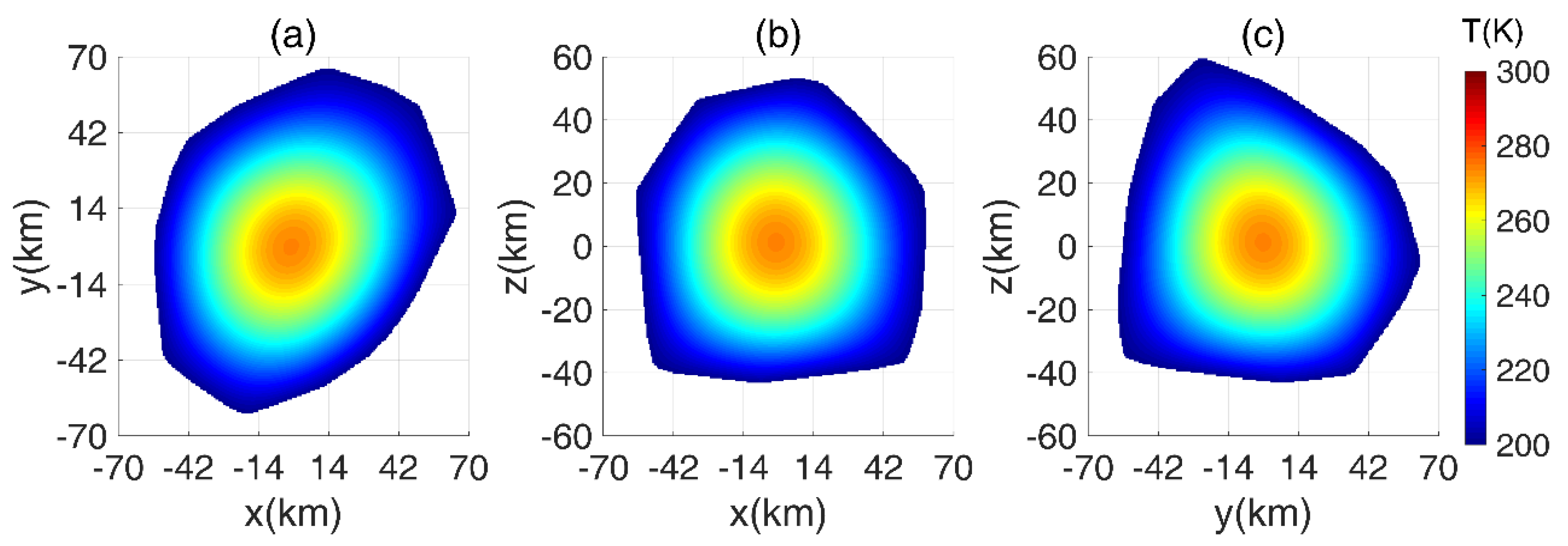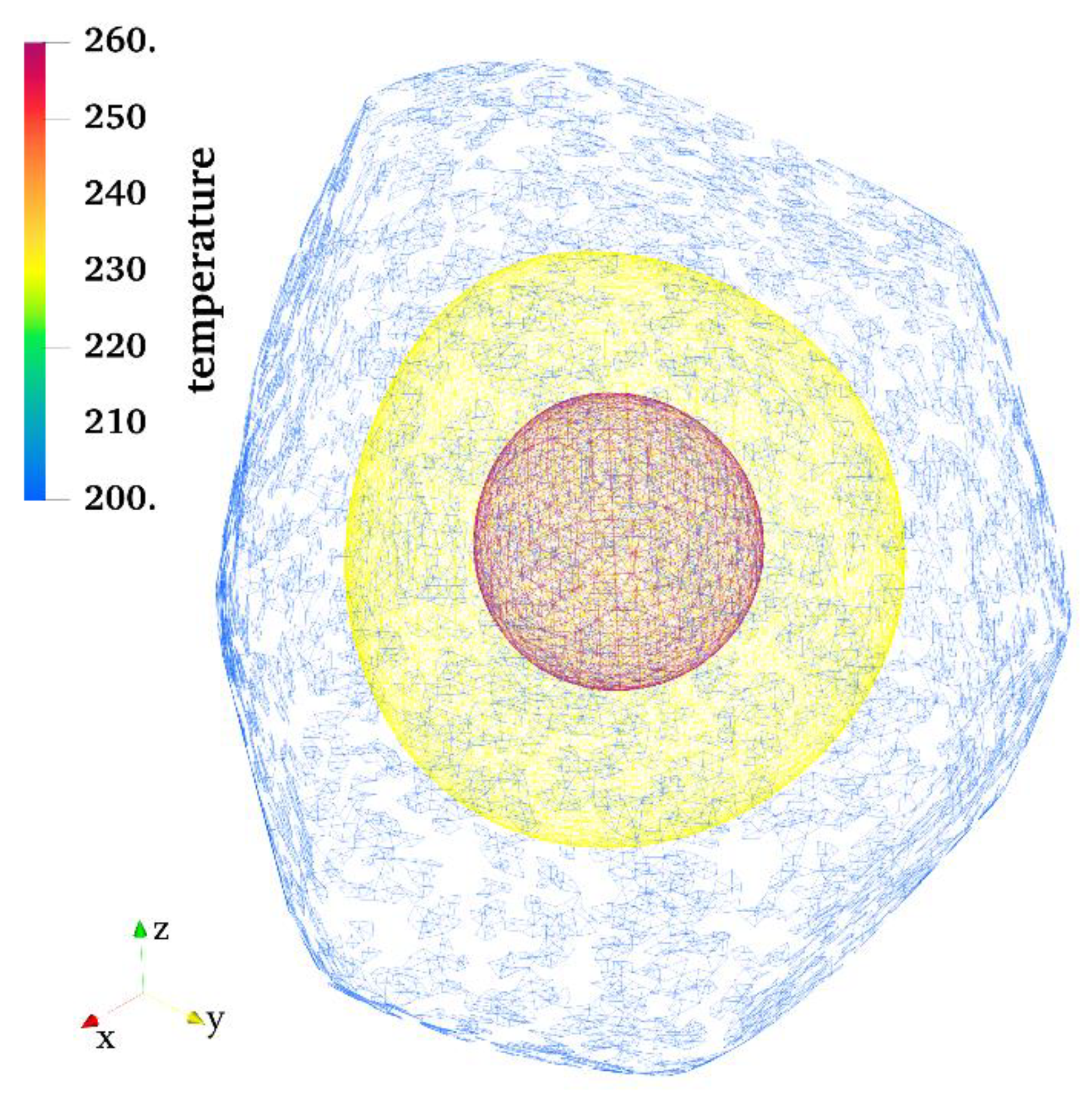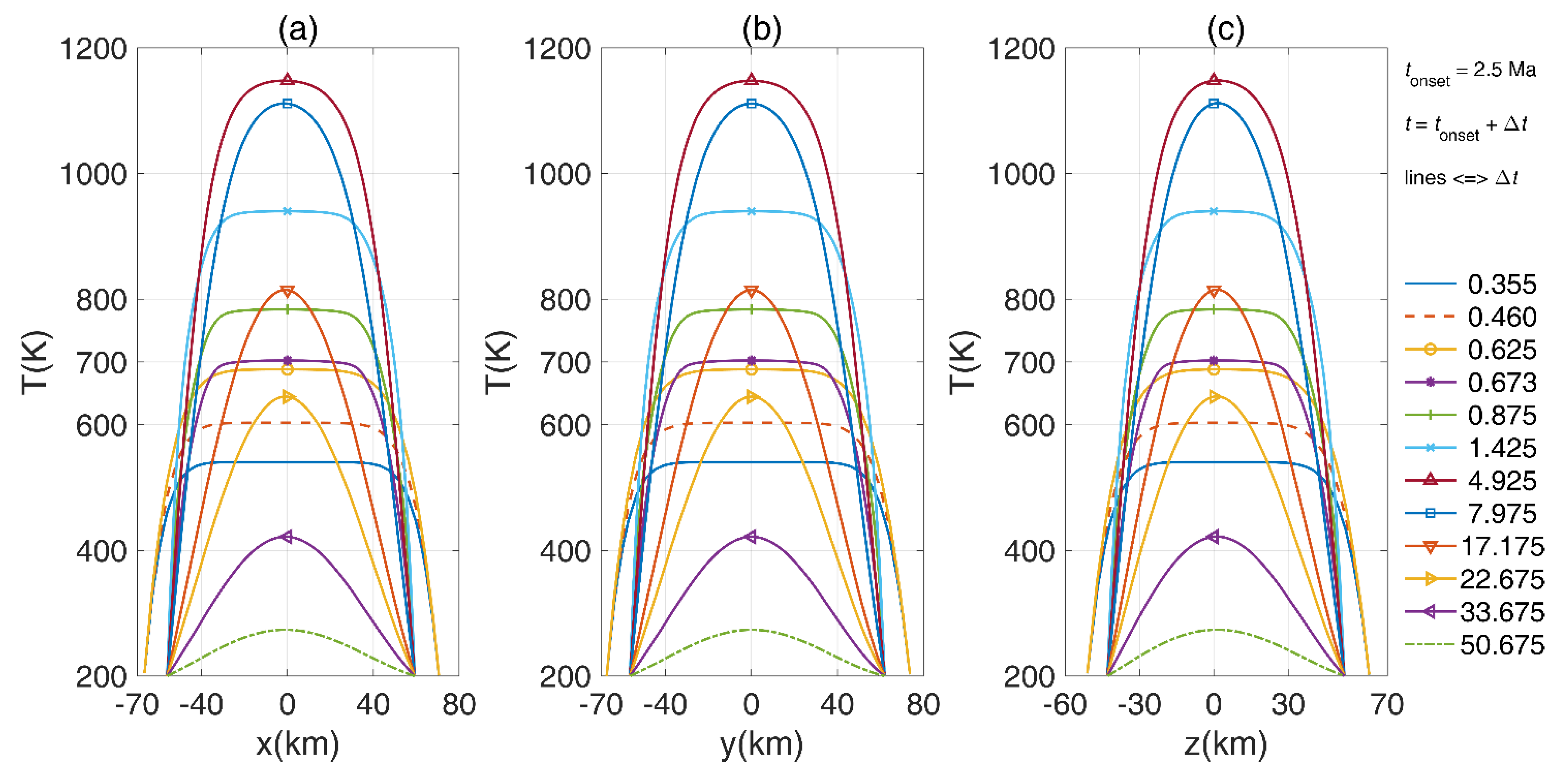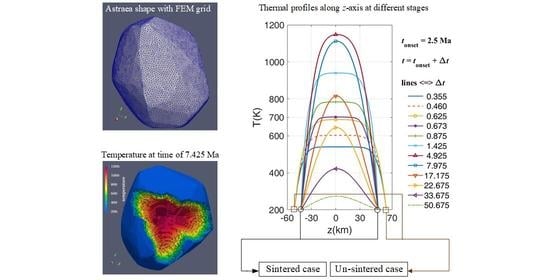1. Introduction
(5) Astraea (hereafter, Astraea) is a large, irregularly shaped asteroid in the main asteroid belt between Mars and Jupiter. The belt survives as a remnant of the protoplanetary disk that formed about 4.56 billion years ago, which is composed of millions of asteroids. Astraea was discovered on 8 December 1845 by the German amateur astronomer Karl Ludwig Hencke [
1]. The mass of Astraea was determined to be 2.9 × 10
18 kg using the gravitational perturbations on the orbits of other asteroids [
2]. The precise determination of the mass of an asteroid is challenging because the gravitational perturbations of asteroids, especially small ones, are difficult to detect [
3]. The mass of Astraea was revised to 2.1674 × 10
18 kg at low accuracy due to its sensitivity to the mass of Juno [
4]. Furthermore, this newly updated mass of Astraea was later revised to a less precise, but more probable, value of 2.64 ± 0.44 × 10
18 kg after an analysis of the gravitational effect of the minor planets on other objects [
5]. The bulk density and porosity of Astraea can be derived from its volume and mineralogy.
The volume of Astraea was determined using photometric light curves. Based on the prevailing optimization methods for asteroid light curve inversion, as proposed by Kaasalainen and Torppa [
6,
7], the photometric light curves provided the primary source of information concerning the asteroid shape. The shape of Astraea derived from its light curves can be downloaded from the Database of Asteroid Models from Inversion Techniques (DAMIT:
https://astro.troja.mff.cuni.cz/projects/damit/ (accessed on 15 September 2022)) created by Ďurech et al. [
8]. The shape of Astraea downloaded from DAMIT is shown in
Figure 1. The spatial grids of this shape are used in our later finite element analysis. Additional resources can be used to further constrain the shape of an asteroid, such as radar data, optical images, and occultation images [
9,
10]. Using All-Data Asteroid Modeling (ADAM), the mean diameter of Astraea was estimated to be 114 ± 4 km [
11], which is consistent with the value of 115 km found in a previous study [
5]. The updated bulk density of Astraea was estimated to be around 3.4 g cm
−3, which is slightly larger than the mean density (~3.26 g·cm
−3) of an S-type asteroid [
12].
The S-type asteroids make up to around 17% of all asteroids in the main belt [
12,
13]. Like most S-type asteroids, Astraea is likely a mixture of nickel–iron and silicates of magnesium and iron [
13]. The main asteroid belt displays a compositional and temperature gradient from its inner to outer parts. The belt provides a record of the decreasing temperature of the protoplanetary disk. The inner region of this disk had a temperature high enough to form solids, whereas the outer more distant part from the proto-Sun is sufficiently cold to give birth to ice and giant gaseous planets [
14]. Like other S-type asteroids, Astraea is denser than most of the C-type bodies and experienced a heating process related to radioactive isotope decay. The heating source is mainly ascribed to the short-lived radionuclide
26Al, as inferred by the Ca–Al-rich inclusion (CAIs) found to be widespread in early solar system grains [
15]. CAIs are the early condensed first solar system objects and are deciphered to include a canonical initial value of 5 × 10
−5 for
26Al/
27Al.
During the early stages of solar nebula evolution, some planetesimals evolved as solid objects in protoplanetary disks to become asteroids. Planetesimals generally experienced collisions owing to gravity perturbations and eventually accreted to form planets. However, some planetesimals escaped accretion and survived as shattered remnants to become the present asteroids [
16]. Asteroids thus provide information about the thermal processes of planetesimals in the young Sun’s solar nebula as well as the parent body of asteroids. Most of the planetary bodies are assumed to have spherical shapes [
17,
18,
19]. Unlike spherical models, the real asteroids are mostly non-spherical due to their lack of quasi-hydrostatic equilibrium. Thus, it is necessary to develop thermal models for asteroids with irregular shapes.
Asteroids with irregular shapes have faster interior cooling due to their large surface area [
19]. As 3-D (three-dimensional) models have a larger surface-to-volume ratio than their 2-D (two-dimensional) counterparts, 3-D thermal models are more suitable for irregularly shaped objects than 2-D models. Sahijpal [
20] recently developed a 3-D thermal model for irregularly shaped objects and found the fastest cooling occurs on the shortest semimajor axis of an ellipsoidal body. Irregular-shaped bodies cool down rapidly due to their large surface area, which allows for more heat loss. To numerically solve the heat conduction equation, Sahijpal tested an explicit 3-D FDM and a fraction-step semi-implicit 3-D Crank–Nicholson method and found these two techniques generated nearly identical results. He further used the explicit 3-D finite difference method to study the possible thermal evolutionary pathways for realistic models of S-type asteroids: (243) Ida and (951) Gaspra. According to Sahijpan [
20,
21], it is necessary to adopt a suitable choice of temporal and spatial grid intervals to achieve numerical stability. Stability is somewhat difficult to achieve when the thermal diffusivity increases rapidly with the compaction of asteroids due to porosity loss. Although Sahijpan [
20,
21] introduced a shape generator logic function to construct realistic 3-D physical shapes for asteroids, dealing with the outer surface of an asteroid continues to be complex when special boundary conditions are applied, such as the Neumann condition. The finite element method (FEM), however, can avoid the instability resulting from unreasonable temporal and spatial grids, and can effectively handle complex boundary conditions [
22].
Based on the FEM developed in this study, we performed simulations of the thermal evolution of Astraea. The specific onset time of accretion and the thermal dynamic properties of Astraea are not yet known. Therefore, we do not claim to give the exact thermal evolution of the asteroid. Instead, our research focuses on the development of a FEM to model the thermal evolution of a wide-range ensemble of asteroids with irregular shapes. This paper is arranged as follows: the methodology is discussed in
Section 2; a comparison between our FEM and a previous FDM is presented in
Section 3; the thermal evolutionary pathway is detailed in
Section 4; and conclusions drawn from the work are summarized in
Section 5.
3. Comparison of Results between FDM and FEM
To validate our methodology, we tested the thermal evolution obtained using our approach. We studied the thermal evolution of a spherically shaped asteroid and compared the results obtained using the FDM and the FEM. The FDM cannot easily deal with boundary conditions. We assume that the grid intervals of the three axes (e.g.,
x,
y, and
z) are denoted by Δ
x, Δ
y, and Δ
z. According to a previous study [
20], the convergence of the FDM depends on the stability factor,
, which is supposed to be lower than 0.5. A small value of ε means small spatial grids, thus indicating a high resolution of spatial grids. Therefore, a small ε in Equation (6) will amplify the stabilizing factor,
R, leading to FDM divergence. To stabilize the FDM, we used a tradeoff where ε was close to 0.025 to ensure an
R approaching 0.202, which is lower than 0.5. Consequently, we apply a spatial grid of Δ
x = Δ
y = Δ
z = 0.25. To validate our approach, we considered a spherically shaped asteroid with a radius of 35 km. Based on a previous study [
20], we used the constant heat diffusivity
k = 8 × 10
−7 m
2·s
−1. The temperature-dependent heat capacity was estimated according to Equation (4). According to Equations (5) and (6), we constructed a shape function,
G(
x,
y,
z), and a boundary shape function,
Gb(
x,
y,
z), to confine the temperature estimated by the FDM. These two shape functions are shown in
Figure 2, where the background nets provide the FDM grids used in temperature calculations.
According to a previous study [
20], the time of accretion,
tonset, of planetesimals to a proto-asteroid is between 1.5 and 3 Ma. We considered the short-lived radionuclide
26Al as the sole heating source, and thus chose the time
tonset = 2.5 Ma in our study.
Figure 3 gives the sectional temperature of the
x-
y plane at the time
t = 3.5 Ma.
The two sub-figures 3a and 3b depict the results of FDM and FEM, respectively. A hot area was observed at the center, and a cold circle was observed on the boundary. The temperature in the center reached 800 K, whereas the boundary temperature stayed around 200 K due to the fixed Dirichlet boundary condition. Both figures show the same temperature magnitude and distribution. Compared with the temperatures shown in
Figure 3,
Figure 4 depicts the reduced size of the high temperature area after 5 Ma from the accretion.
The two sub-figures 4a and 4b illustrate a similar variation in temperature. From the results shown in
Figure 3 and
Figure 4, it can be concluded that the FEM results are generally consistent with those from the FDM, indicating the feasibility of our algorithm. As heat is lost from the asteroid, the thermal energy from the decaying radionuclide
26Al is not sufficient to further heat the interior of the body. The temperature decreases over time as presented in
Figure 5 and
Figure 6.
Figure 5 demonstrates that the size of the hot area further decreases so that the maximum temperature is reduced to around 700 K after 10 Ma from accretion. Although the two sub-figures 5a and 5b show similar results, there is a slight difference in the centers which displayed hot areas.
Figure 5b shows a slightly larger hot center than that shown in
Figure 5a.
Figure 6 shows the temperature distribution after 20 Ma from accretion.
Figure 6 indicates that the interior of the asteroid continues to lose heat and that the maximum temperature is confined to 400 K. The two sub-figures 6a and 6b show the same variation in temperature, but there is a small difference in the center of the body.
Figure 6a indicates that the maximum temperature in the center of the body is within 360 K, whereas
Figure 6b shows a maximum value of 380 K in the center. This discrepancy could likely be due to the limited size of the boundary thickness in the FDM. The FDM is theoretically supposed to have a boundary with a tiny thickness. However, the limited spatial grid space (Δ
x = Δ
y = Δ
z = 0.25) cannot further reduce the modeled thickness of the asteroid’s surface boundary.
Figure 2b shows the distribution of the boundary, which is clearly thick. Conversely, the FEM does not limit the thickness of the boundary due to the self-adapting grid.
Figure 7 shows the FEM grid on the
x-
y plane, where the boundary is represented by the nodes in the boundary grids.
Figure 7 shows that the FEM can more effectively deal with the boundary condition than the FDM because the physical boundary is well represented by the lines of the FEM grids on the boundary. We subsequently used the FEM to study the likely thermal evolution of the irregularly shaped Astraea.
4. Thermal Evolution of the S-Type Asteroid Astraea
After testing the FEM, we applied the approach to study the likely thermal evolution of Astraea. Using the shape of Astraea, we fixed its surface temperature to a constant value of 200 K. Based on a previous study [
20], we assumed the accretion of planetesimals lasted 2.5 Ma. We also tested the short case of
tonset = 1.5 Ma and found the maximum temperature increased to more than 1500 K. Iron melting would commence at that temperature, but discussing this scenario is out of the scope of this study. After dozens of tests and referring to a previous study [
20], we assumed the accretion lasted 2.5 Ma (i.e.,
tonset = 2.5 Ma), and found the likely temperature contours after 0.46 Ma, as shown in
Figure 8.
The two sub-figures 8a and 8b illustrate the sectional temperature variations along the
x-
y plane and the
x-
z plane. The two figures indicate a high temperature close to 600 K in a large part of the interior, whereas the surface is cold at 200 K due to the fixed surface temperature.
Figure 8c shows the temperature distribution along the
y-
z plane, and indicates a similar magnitude of temperature to those in
Figure 8a,b. A maximum temperature lower than 700 K indicates that the body is not yet un-consolidated. The body will continue to heat up due to the radioactive decay of
26Al. By the end of the accretion of planetesimals, the body will have spent 4.925 Ma being heated to a high temperature such as those seen in
Figure 9.
Figure 9a–c indicate that a large part of the interior of Astraea is heated to a temperature greater than 1000 K, whereas the center of the body can rise up to 1150 K. The shape of the high temperature at the interior is to some extent similar to the shape of Astraea, but the interior is smoother than the surface shape. Comparing the grids shown in
Figure 8 and
Figure 9, the grid limitations in
Figure 9 are smaller than those shown in
Figure 8. Since the compaction of an asteroid commences at around a temperature of 700 K [
24], the body experienced consolidation at the time
t = 7.425 Ma. Following previous studies [
20,
24], we assumed the body experienced reduction in three steps by a factor of ~1.06 in the temperature range of 670–700 K. The initial spatial grids were compacted by a factor of 1.2 to generate the final grids. The grids shown in
Figure 9 are thus smaller than those in
Figure 8 by a factor of ~1.2. Additionally, we provide a stereogram of the temperature distribution at time 7.425 Ma, as shown in
Figure 10.
To display the temperature contours of the interior, we made a gap on the surface as shown in
Figure 10. The rough grains in the interior represent the geometrical elements used in the FEM. Viewing through the gap we found that the temperature of the interior, especially around the body’s center, is close to a high value of 1200 K. As the heat conducts from the interior to the outer surface, the temperature decreases gradually to 200 K on the surface. With the loss of heat, the body cooled gradually after 7.425 Ma. Until 25.175 Ma, the interior of the body cooled as shown in
Figure 11.
Figure 11 indicates that the temperature in the body’s center is less than 700 K. The size of high temperature area is smaller than in the previous period. There are regions near the boundary with low temperatures of around 300 K. After 50.675 Ma from accretion, the interior of the body further cooled, and the temperature decreased to lower than 300 K, as in
Figure 12.
Figure 12a–c show that the high temperature area is concentrated around the center and has a temperature of around 260 K.
Figure 13 presents a stereogram of the temperature distribution of this feature with three iso-surfaces.
As seen in
Figure 13, the three iso-surfaces from the outer surface to the inner surface represent temperatures of 200 K, 230 K, and 260 K. The inner iso-surface appears as a small red sphere, indicating the body cooled to be approximately heat balanced with the external space. The temperature gradient declined as the temperature decreased. Thus, the heat loss occurred more slowly than in the case of the high temperature state.
Figure 14 gives the thermal profiles along the
x-axis (a),
y-axis(b), and
z-axis (c).
The curves in the panels of
Figure 14 represent temperature variation at various stages after the accretion of planetesimals (
tonset=2.5 Ma). After accretion at 0.355 Ma, the solid blue curves in the three panels indicate that the interior of the body heated to 540 K.
Figure 14a demonstrates that the distance along the
x-axis is around 136.8 km, close to the distance (~140 km) along
y-axis shown in
Figure 14b.
Figure 14c shows the shortest distance along
z-axis, where the distance approaches 113 km. Since the maximum temperature is lower than 700 K, the target asteroid did not experience consolidation. The un-consolidated state continues to the time of 0.46 Ma based on the brown curves in the three panels of
Figure 14, which indicate that the interior of Astraea heated to 600 K. As the interior of the target body was further heated by radioactive decay, the solid orange lines with circles in the three panels depict that the interior of Astraea further heated to 688 K after 0.625 Ma, indicating that the body was experiencing compaction or consolidation due to porosity loss. Subsequent to accretion after 0.625 Ma, the solid purple curves with asterisks in
Figure 14 show that the interior of the target body heated to 701 K, and slightly higher than 700 K. The slightly higher temperature indicates the end of compaction; thus, the distances were shortened along the three axes after that time. The distance along the
x-axis in
Figure 14a shortened from 136.8 km to around 114 km, whereas the distance along the
y-axis in
Figure 14b shortened from 140.8 km to nearly 117 km. The distance decreased from 113 km to around 94 km along the
z-axis, as shown in
Figure 14c. Although the target asteroid experienced consolidation after 0.625 Ma, its interior continued to heat up to a high temperature due to radioactive activity during the following stages.
The solid brown curves with an upper triangle in
Figure 14 indicate that the interior of the target body was heated to the maximum temperature close to 1150 K after the time of 4.925 Ma. The maximum value of 1150 K is the largest temperature in our model; thus, the body did not experience iron melting in our computation. After the warmest state, the body in the following periods cooled down due to insufficient radioactive decay energy from
26Al. Until to the time
t =
tonset + 50.675 Ma = 53.175 Ma, the dashed green curves in the three panels of
Figure 14 indicate the body cooled down sharply and that the temperature of the interior was around 260 K. Although the thermal profile along the
z-axis is slightly distinct with those along the
x- and
y-axes in
Figure 14, we did not find an apparent fast cooling with respect to the cooling rate in the shortest
z-axis, which was found in a previous study [
21]. This slowly cooling rate is likely associated with the unapparent differences in the distances along
z-axis and the
x- and
y-axes in Astraea. However, the distances along
z-axis are much smaller than the other two axes in the asteroid (243) Ida as previously studied.
5. Conclusions
Most asteroids are shattered remnants resulting from planetesimals that escaped from protoplanet accretion. Studying the thermal pathways of asteroids can help to understand the thermal processes of the planetesimals in the young Sun’s solar nebula. Modeled asteroids are generally supposed to have regular shapes; however, most real asteroids have irregular shapes due to their lack of quasi-hydrostatic equilibrium. The irregular shapes have larger surface areas than regular models. Large surfaces result in faster cooling than regular models. Although previous research has explored the thermal pathways of irregular shapes of asteroids using the FDM, it is a quite complex task to achieve stability and to deal with boundary conditions using the FDM. To explore the likely thermal pathways of irregular shapes of asteroids, we developed a FEM to infer the thermal evolution of the irregularly shaped Astraea asteroid.
We made a comparison of thermal results from the FDM and the FEM by considering a spherical model with a radius close to 35 km. The two algorithms gave similar results for the same evolutionary time, especially at the stage when the models had temperatures around 800 K. However, the two methods showed a slight difference in temperature owing to heat loss because the FDM is unlikely to achieve a thin boundary. Conversely, the FEM does not consider the thickness of boundary due to its self-adapting grid. Based on the shaped data provided by DAMIT, we further explored the likely thermal evolution pathway of the Astraea S-type asteroid. To explore the likely thermal pathway, we considered the accretion lasting 2.5 Ma to prevent iron melting in the target body and accounted for consolidation owing to porosity loss.
The results show that the shape of the high temperature area in the interior is similar to the shape of Astraea, indicating the influence of the irregular shape on thermal evolution. After the accretion of planetesimals, the interior of Astraea spent 4.925 Ma reaching a high temperature of nearly 1150 K. Subsequently, Astraea gradually cooled due to insufficient radioactive isotope decay and required more than 50 Ma to approximately balance heat to its external space. In addition, we did not find signs of fast cooling in the shortest z-axis as reported in a previous study. This can likely be ascribed to the unapparent differences of distances along the axes of Astraea. This methodology can be applied to the thermal pathways of other irregularly shaped asteroids given the advantages of the FEM as developed in this study.
